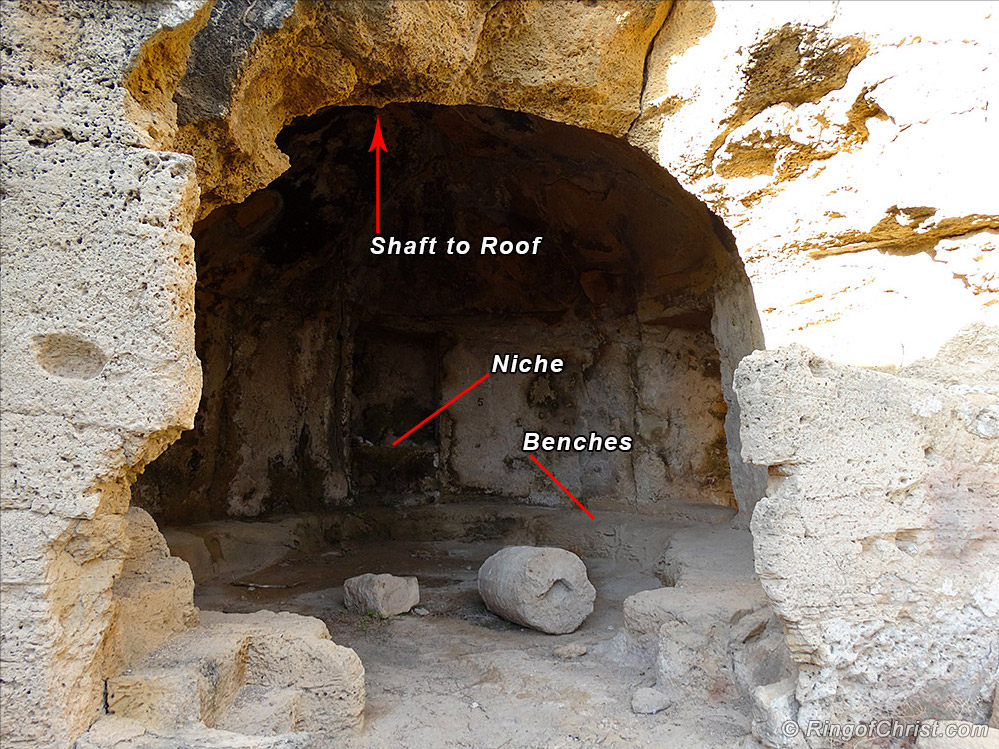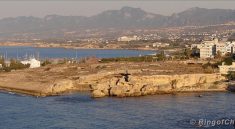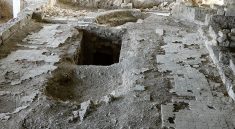In 1998 Italian archaeologists began work in the northwest area of Nea-Paphos UNESCO World Heritage Site (“Garrison’s Camp.”) Among other things the area excavated contains a temple complex from the Hellenistic and Roman Periods. Archaeologists also believe they could have also found the underground church area of St. Hilarion (291-371A) in the caves that were abandoned by the pagans and re-purposed by the Christians in the 4th Century.


The foundations of two small basilicas are adjacent to the caves indicating it was an early Christian site, but more of this in a moment. Atop the underground sanctuary, and in addition to the foundations of the temple area and its adjoining cistern, the archaeologists from Catania unearthed a dromos (hallway) over seventy feet long and less than a meter wide.


The priests and priestesses would have moved unseen from the temple on the surface to the subterranean sanctuary, adding to the mystery of the cult.
One significant part of underground sanctuary is a domed chamber that could well have been a place where Mithra, (Sol Invictus) was worshiped.

It has all of the components of a mithraeum: it’s underground, has benches all around for the reclining meal, an apse-shaped wall with a pedestal altar opposite the entry, and a drilled hole in the ceiling to let in a ray of light.
The Imperial Cult was combined with Aphrodite in Palaepaphos. If there were a Mithraeum present, it appears that this temple worshiped the Emperor God as well as Sol Invictus through Mithra; however, archaeologists have not confirmed the presence of a Mithraeum in this underground complex.
In 342 AD, Paphos was totally destroyed by a major earthquake. When St. Hilarion arrived in about 363AD, the city had long since been abandoned, never to be rebuilt again. The temple complex as well as all of the major structures were not fit for habitation.
Jerome tells us that when St. Hilarion came to devastated Paphos, only the magnificent ruins showed its past greatness.

Hilarion lived among the rubble in obscurity for about 20 days, then over 200 people from as far as Salamis, Lapithos, and Kourion came to him. For two years he worked miracles on those wanting to be cured and saved.
Then he sought refuge in the mountains north of Paphos. The underground church would afterwards have been used for evangelizing while the cave in the hills near Paphos, as local tradition holds, was used as a getaway by the saint, who was increasingly ‘vexed and annoyed’ by the crowds of pilgrims.

St. Jerome tells us that the saint slept on rushes. The bed-shaped indentation in the picture to the right (most probably an earlier tomb), could have been filled with ‘rushes’ to make just such a sleeping place. St. Hilarion would have not wanted or required more.
The passageway outside of the tiny room originally connected the monk’s cell with the first church, but at some point it was sealed off with stone. The circular chamber (mithraeum) adjacent to the ‘monk’s cell’ would have been a perfect place to gather. The long vaulted room next to the mithraeum could have been the first humble church.
Of course, this is speculation, but it all fits perfectly when one considers how the first Christian communities worshiped together in secret places.
Building a shrine to St. Hilarion in the place of his first miracles would be exactly what Christians of any age would do. It is not unrealistic that the excavated areas could easily have been two small basilicas, a cave church, monks cells, meeting areas, a vaulted church, chapels, and shrine begun in the 4th Century as a memorial to St. Hilarion.





